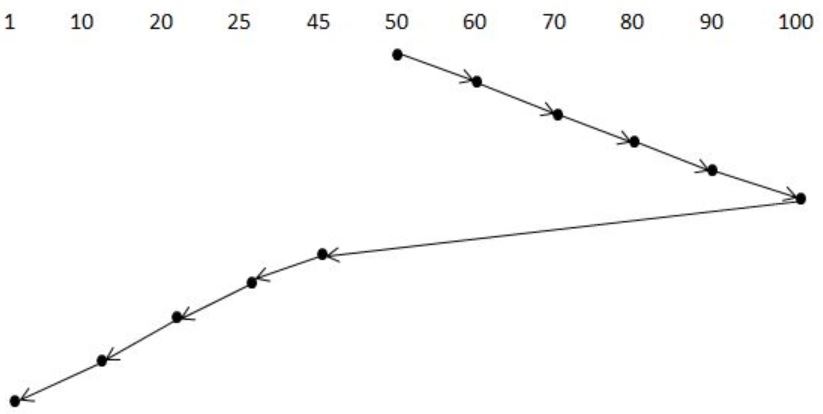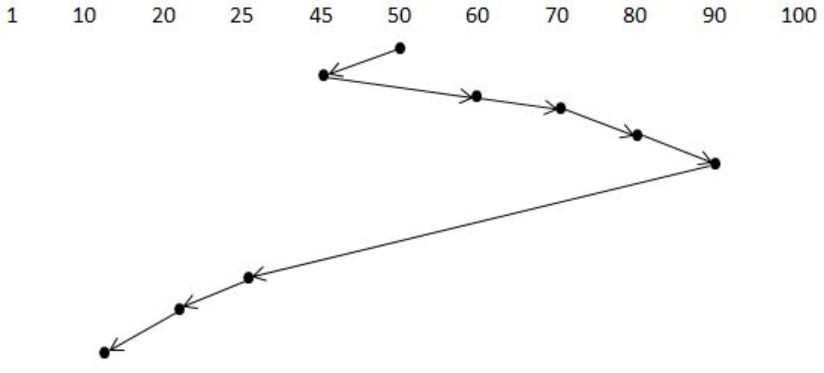Disk-Scheduling
Question 1 |
The head of a moving head disk with 100 tracks numbered 0 to 99 is currently serving a request at tract 55. If the queue of requests kept in FIFO order is
10, 70, 75, 23, 65
Which of the two disk scheduling algorithms FCFS (First Come First Served) and SSTF (Shortest Seek Time First) will require less head movement? Find the head movement for each of the algorithms.
Theory Explanation. |
Question 2 |
Consider the following five disk access requests of the form (request id, cylinder number) that are present in the disk scheduler queue at a given time.
(P, 155), (Q, 85), (R, 110), (S, 30), (T, 115)
Assume the head is positioned at cylinder 100. The scheduler follows Shortest Seek Time First scheduling to service the requests.
Which one of the following statements is FALSE?
The head reverses its direction of movement between servicing of Q and P. | |
T is serviced before P. | |
R is serviced before P. | |
Q is serviced after S, but before T.
|

Question 3 |
Consider a storage disk with 4 platters (numbered as 0, 1, 2 and 3), 200 cylinders (numbered as 0, 1, … , 199), and 256 sectors per track (numbered as 0, 1, … 255). The following 6 disk requests of the form [sector number, cylinder number, platter number] are received by the disk controller at the same time:
- [120, 72, 2], [180, 134, 1], [60, 20, 0], [212, 86, 3], [56, 116, 2], [118, 16, 1]
Currently head is positioned at sector number 100 of cylinder 80, and is moving towards higher cylinder numbers. The average power dissipation in moving the head over 100 cylinders is 20 milliwatts and for reversing the direction of the head movement once is 15 milliwatts. Power dissipation associated with rotational latency and switching of head between different platters is negligible.
The total power consumption in milliwatts to satisfy all of the above disk requests using the Shortest Seek Time First disk scheduling algorithm is ______ .
85 | |
86 | |
87 | |
88 |
→ A storage disk - 4 platters(0, 1, 2 & 3), Cylinder - 200 (0, 1, …, 199) , 256 sector per track.
In the above question the disk requests are given in the form of 〈sector no, cylinder no, platter no〉.
In SSTF (Shortest Seek Time First) Disk Scheduling algorithm, requests having shortest seek time are executed first.
So, the seek time of every request is calculated in advance in queue and then they are scheduled according to their calculated seek time. Head is positioned at 80 and moving towards higher cylinder no.

Head Movement in SSTF = (86 – 80) + (86 – 72) + (134 – 72) + (134 – 16) = 200
P1: Power dissipated by 200 movements = 0.2 * 200 = 40 mW
Power dissipated in reversing Head direction once = 15 mW
No. of times Head changes its direction = 3 P2: Power dissipated in reversing Head direction = 3 * 15 = 45 mW
Total power consumption is P1 + P2 = 85 mW
Question 4 |
Which of the following disk scheduling strategies is likely to give the best through put?
Farthest cylinder next | |
Nearest cylinder next | |
First come first served | |
Elevator algorithm |
Nearest cylinder next - SSTF
First come first served - FCFS
Elevator - SCAN
SSTF always serves the request of nearest cylinder first. Due to which the necessary movement gets reduced.
Question 5 |
Where does the swap space reside?
RAM | |
Disk | |
ROM | |
On-chip cache |
When memory is full and process needs memory, inactive parts of process are put in swap space of disk.
Question 6 |
Using a larger block size in a fixed block size file system leads to:
better disk throughput but poorer disk space utilization | |
better disk throughput and better disk space utilization | |
poorer disk throughput but better disk space utilization | |
poorer disk throughput and poorer disk space utilization
|
Question 7 |
Consider an operating system capable of loading and executing a single sequential user process at a time. The disk head scheduling algorithm used is First Come First Served (FCFS). If FCFS is replaced by Shortest Seek Time First (SSTF), claimed by the vendor to give 50% better benchmark results, what is the expected improvement in the I/O performance of user programs?
50% | |
40% | |
25% | |
0% |
→ The better vendor benchmark results doesn't effects the I/O performance.
→ In FCFS (or) SSTF only one choice is to choose for IO from multiple IO's. There is always one I/O at a time.
Question 8 |
A Unix-style i-node has 10 direct pointers and one single, one double and one triple indirect pointers. Disk block size is 1 Kbyte, disk block address is 32 bits, and 48-bit integers are used. What is the maximum possible file size?
224 bytes
| |
232 bytes
| |
234 bytes | |
248 bytes |
= 10 + 28 + (28)2 + (28)3
= 224 Blocks (App)
Size of each block = 210
Maximum file size = 224 × 210 = 234
Question 9 |
The head of a hard disk serves requests following the shortest seek time first (SSTF) policy. The head is initially positioned at truck number 180.
Which of the request sets will cause the head to change its direction after servicing every request assuming that the head does not change direction if there is a tie in SSTF and all the requests arrive before the servicing starts?
11, 139, 170, 178, 181, 184, 201, 265 | |
10, 138, 170, 178, 181, 185, 201, 265 | |
10, 139, 169, 178, 181, 184, 201, 265 | |
10, 138, 170, 178, 181, 185, 200, 265 |

Hence, correct option is (B).
Question 10 |
The head of a hard disk serves requests following the shortest seek time first (SSTF) policy. The head is initially positioned at track number 180.
What is the maximum cardinality of the request set, so that the head changes its direction after servicing every request if the total number of tracks are 2048 and the head can start from any track?
9 | |
10 | |
11 | |
12 |
1) The alternating direction with SSTF policy.
2) Maximize the no. of requests.
The first condition can be satisfied by not having two requests in the equal distance from the current location. As shown below, we must not have request located in the circle marked positions.
Now to maximize the no. of request we need the requests to be located as compact as possible, which can be done by just placing the request in the next position after the circle marked position in particular direction (the direction in which the head need to move).
Now to satisfy the 1st criteria:

Seek length sequence for maximum cardinality and alternating head movements:
→ 1, 3, 7, 15, ...
→ or, 21-1, 22-1, 23-1, 24-1, ...
→ We have 2048 tracks so, maximum swing (seek length) can be 2047.
→ Which corresponds to a seek length of 211-1 in the 11th service.
Question 11 |
Suppose the following disk request sequence (track numbers) for a disk with 100 tracks is given: 45, 20, 90, 10, 50, 60, 80, 25, 70. Assume that the initial position of the R/W head is on track 50. The additional distance that will be traversed by the R/W head when the Shortest Seek Time First (SSTF) algorithm is used compared to the SCAN (Elevator) algorithm (assuming that SCAN algorithm moves towards 100 when it starts execution) is _________ tracks.
10 | |
11 | |
12 | |
13 |

∴ Total head movements,
= 10 + 10 + 10 + 10 + 10 + 55 + 20 + 5 + 10
= 140
SSTF:

∴ Total head movements
= 5 + 15 + 10 + 10 + 65 + 5 + 10 + 10
= 130
∴ Additional distance that will be traversed by R/W head is
= 140 - 130
= 10
